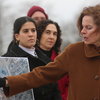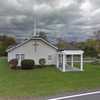Is the KKK in Altamont?
This season's "Intelligence Report" put Altamont on its Hate Map. Read the Enterprise editorial.
ALTAMONT —The Southern Poverty Law Center, an internationally known organization that tracks the activities of hate groups in the United States, has put Altamont on the map — the Hate Map.
Published last month in the center’s Spring 2015 “Intelligence Report,” and posted online at its website, www.splcenter.org, the Hate Map for 2014 lists Altamont as the only location in New York State to have an active chapter of the Ku Klux Klan. This information about Altamont has been repeated recently by various media outlets including the Syracuse Post-Standard.
The Loyal White Knights of the KKK website lists two chapters in New York State, in Altamont and Buffalo.
Wednesday afternoon, Altamont’s police chief, Todd Pucci, met with representatives of the Federal Bureau of Investigation, the New York State Police, the Albany County Sheriff’s Office, and the Guilderland Police Department. (The Enterprise was not allowed to cover the session because, Pucci said, the FBI agents work undercover.)
“None of us have any substantiation of any chapter of the KKK here,” said Pucci after the meeting. “The most recent activity in this area was back in the 1920s.”
Altamont’s mayor, James Gaughan, expressed similar doubts. “We have no local evidence of any kind here from citizens, the media, or from law enforcement. Here in this village, where I know so many people, I am still stretched to believe these claims.”
Gaughan, who is openly gay, also said, “As I investigate this, I am having one heck of a time trying for my own self personally, as a member of a protected class myself, as well as part of my responsibility as mayor, to assess the reality here, so that we can first of all provide education and provide information, so people don’t unnecessarily get haunted by their memories of the past, of how this organization terrorized people.”
Pucci also pointed out that the Altamont ZIP code is much wider than the village proper, and that any activity, if it really exists, could be in an outlying area. He went on to say that Klan members, like anyone else, have First Amendment rights to freedom of speech and to peaceable assembly. “If they did rally, then we’d be the first out in the street to block traffic,” he said.
The police chief reiterated, though, that there had been no interaction between Klan members and law enforcement in the region, and he expressed frustration that he, along with members of other local law enforcement agencies, had not had calls returned from the Southern Poverty Law Center.

The not-for-profit center, located in Montgomery, Alabama, is known for representing victims of hate groups and for educational programs promoting tolerance. It publishes a Hate Map each year, showing the locations of what it calls “active hate groups.” The center defines hate groups as having “beliefs or practices that attack or malign an entire class of people, typically for their immutable characteristics.”
In the 2014 Hate Map published by the group in early March, there were a total of 44 groups listed across New York State. Most of New York’s hate groups operate out of the five boroughs of New York City. Just two states had more hate groups: California with 57 and Florida with 50. There was only one site in New York State said to be home to the KKK, and it was Altamont.
Heidi L. Beirich, director of the SPLC’s Intelligence Project, which produces both the annual Hate Map and the quarterly “Intelligence Report,” a journal that reports on the activities of the radical right, said that in many cases the way that the SPLC finds out about hate groups is through tracking of online activity. She checked into the specific information that she had on file about Altamont and found that the information about Altamont came not from web-traffic tracking, but from a tip from an unnamed “law enforcement source.”
In addition, she said, Altamont was also listed on the map posted on the website of the Loyal White Knights of the KKK, showing where their chapters are located. Altamont was newly listed on the Klan group’s website, she said; it was not there last year.
When pressed numerous times by The Enterprise to reveal the name of the agency or the individual who was her law enforcement source — or to pass that information directly to the Altamont Police if she preferred — Beirich said that she had checked back with her source, and that source “did not want to talk.”
The Enterprise this week called all of the following agencies in an effort to find the SPLC’s “law enforcement source”: the Guilderland Police; the Albany County Sheriff’s Office; the New York State Police; the New York State Division of Homeland Security in Albany; the FBI Albany Field Office; FBI headquarters in Washington, D.C.; and the Criminal Justice Information Services Division of the FBI. All said that they knew nothing about the situation and that they were not the source.
The only thing she would specify, Beirich said, was that the source had said there was “a small cell of Klansmen active in that area.”
KKK history
The idea that the group, if it exists, is small, coincides with what The Enterprise learned from another staff member at SPLC. Senior Fellow Mark Potok, who is the editor-in-chief of “Intelligence Report,” said that the Klan today has about 4,000 members nationwide, divided into about 25 splinter groups, all claiming to be the “one true Klan.” They often inflate their numbers, he said.
The Ku Klux Klan is the most infamous and one of the oldest of America’s hate groups, says the website of the Southern Poverty Law Center. It was formed at the end of the Civil War and started out as a vigilante group to intimidate Southern blacks and prevent them from enjoying basic civil rights. The Klan’s use of hooded white robes, violent “night rides,” and nighttime cross-burnings all increased the public’s fear. Lynchings, tar-and-feathering of victims, rapes, and other violent attacks became hallmarks of the group.
Potok gave The Enterprise a thumbnail history of the Klan. The group has risen and fallen four or five times in its history, he said.
The Klan was fairly large during Reconstruction, from about 1865 to 1871, mostly in the South. But in the 1920s it became a national organization and reached its peak membership; by the mid-twenties there were about four million Americans in the Klan, when the country’s population was about 106 million.
The so-called “third-era Klan” arose in response to the Civil Rights movement and the U.S. Supreme court’s 1954 decision in Brown v. Board of Education of Topeka, declaring separate public schools for black and white students unconstitutional. Membership in the third era peaked in the mid-1960s, when the United States population was about 194 million, with about 40,000 Klan members.
Today they’re down, Potok estimated, “to probably 4,000 or something like that,” with those 4,000 Klansmen divided into about 25 Klan groups that go by different names. The Klan today, Potok said, “is very small, very weak, divided amongst various people claiming to be the ‘one true Klan.’”
The description of the Klan on the SPLC website estimates total membership in the United States at between 5,000 and 8,000.
Mapping hate
A hate group’s activities, according to the The Southern Poverty Law Center, can include any of the following: “criminal acts, marches, rallies, speeches, meetings, leafleting or publishing.” The SPLC notes that websites “appearing to be merely the work of a single individual, rather than the publication of a group,” are not included on its Hate Map.
The most recent Hate Map listed 784 chapters of hate groups active throughout the country. Some examples of the 44 groups listed in New York State are the Black Riders Liberation Party in Albany (listed on the map as a “black separatist” organization); the “neo-Nazi” Golden Dawn in Astoria; the “anti-Muslim” Radio Jihad in Little Falls; and the “anti-LGBT” Jewish Political Action Committee in New York.
The Enterprise called the telephone number listed on the website of the Loyal White Knights of the Ku Klux Klan, which gives a post office box address in Pelham, North Carolina. The group’s answering-machine message was delivered in a deep Southern drawl that started out with the phrase “Racial greetin’s” and went on to heap vitriol upon lesbian and gay individuals (the terms actually used were “homosexuals,” “faggots,” and “lesbian sluts”), referred to Bible passages that supposedly advocate putting homosexuals to death, and concluded, “Praise God for AIDS.”
According to the website, members must attend at least one rally per year to keep their membership active. The group also has events called “meet and greets,” which are “almost like a klan rally but with out (sic) the cross-lighting.” The rallies, meanwhile — presumably with cross-lighting — “are like a back yard BBQ” and have “Just all whites there.”
The Enterprise left a message and got a return call (from a “private caller”) from a Robert Jones, who said he was the Grand Dragon of North Carolina. He said that the group had chapters “all throughout New York State,” and specified the number at “about four.” He said that there was one in Buffalo. Buffalo is the only location other than Altamont listed on the Loyal White Knights of the KKK website map of its chapters.
Jones mentioned that there was a rally planned for the last week of May in New York State, but balked at giving more details.
He offered to have one of the New York leaders call.
A couple of hours later, one did, again with a blocked number. He said his name was Douglas Barker, that he lived on Long Island, and that his title was the “Exalted Cyclops” for the Loyal White Knights of New York.
Barker claimed that there were KKK groups “throughout upstate,” including one with “400 to 500 members.” That one, he said, is in Syracuse.
Barker himself did not mention Altamont. When asked about it, he said, “Oh yes, there’s a group there.” When asked how large it was, he was vague, answering, “It’s up in the hundreds, I’ll tell you that.”

Potok, with the Southern Poverty Law Center, said flatly, when told about the numbers that Barker had quoted for upstate New York membership, “Let me say simply that he’s lying. That is completely false. It’s very typical of these groups to claim 40 members when they have four, and 4,000 when they have 40.” He added, “He is absolutely full of it. It’s simply not true.”
Mayor Gaughan noted that the Altamont ZIP code is “massive compared to the 1,720 residents of Altamont's one-mile-square village.” He added, “If there were hundreds of members of the KKK in Altamont, they would represent the largest single group in the village (including churches, community groups, Altamont Community Tradition, etc.) — in fact, probably bigger than all or most of them combined. Literally, a statistical improbability of the largest order.”
Asked how certain the SPLC is when it lists a town on its Hate Map, Potok responded, “Sometimes when a group says it has a chapter in a particular place, what they really mean is that somebody keeps a post office box in that town for their group, but they and their little group of friends are actually two towns over. Sometimes that does happen.
“And a number of hate groups will do that, simply to keep local heat off of them, and all they do is they go over to the next town over to pick up their mail. I think more often than not, the groups are where they say they are, but they do routinely overstate their size.”
The Enterprise asked the Southern Poverty Law Center why Long Island doesn’t appear on the Hate Map, since there was an incident in August 2014 when flyers and candy were left in sealed plastic bags on the driveways of homes in Hampton Bays on Long Island. Beirich said that the SPLC had no way of knowing where the flyers originated — whether someone drove in with them from another location, or if there was actually a KKK presence in that local area.
When asked by The Enterprise where he grew up, Barker answered, “Shirley, Long Island.” Shirley is about 30 minutes west of Hampton Bays.
Barker has the same last name as the woman named on the group’s website as being in charge of membership applications, Amanda Barker, who is listed as being in Pelham, North Carolina. Barker also has the same last name as the person listed on the website as being, since 2011, the “Present Imperial Wizard of the Loyal White Knights of the Ku Klux Klan,” Chris Barker.
Barker said that what he did for a living was “volunteer work.” He said that he helps “people in need.” When asked how he makes a living, he said that his family helps him.
Told about the proliferation of Barker names, Potok of the SPLC said, “A lot of these Klan groups are built around a single family.”
The fact that Klan events were held in the Altamont area almost a hundred years ago, when the group nationwide was at its peak in the 1920s, is well documented. The village archives has in its holdings memorabilia from the deceased secretary of the Indian Ladder chapter of the Ku Klux Klan, including requisition forms for robes and helmets, pamphlets with covers showing torch-carrying riders, and meeting minutes.
A variety of notices and advertisements about Klan events from that period appeared in The Enterprise including one in Voorheesville in 1927, New Salem in 1928, and New Scotland in 1930.
The current mayor is convinced that that dark history is not a modern reality.
“The last thing I want to see happen,” said Gaughan, “is that the village’s reputation as a wonderful, safe, and welcoming community is destroyed in the process of seeking to assess the validity of these claims.”
Corrected and updated on April 13, 2015: The printed version of this story listed two other media outlets besides the Syracuse Post-Standard as reporting that Altamont was on the Southern Poverty Law Center Hate Map; they were removed because the references could not be verified. Since the Enterprise article was printed, on April 2, 2015, several other media outlets have reported on the designation.



